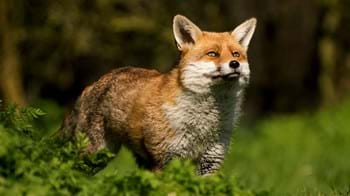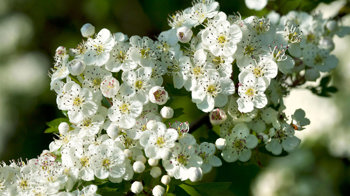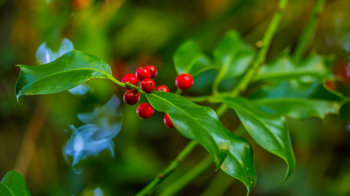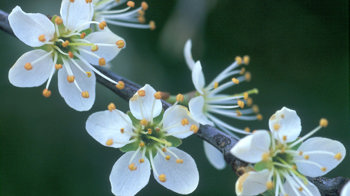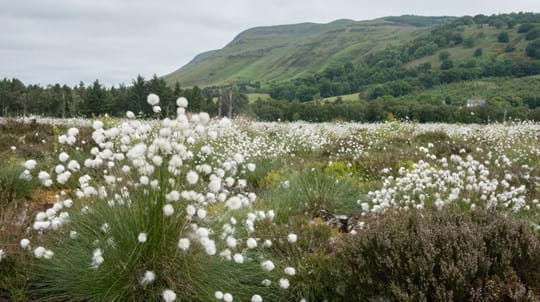
Kilmagad Wood
Scotlandwell Loch Leven

Woodland Trust wood group
- Kilmagad Wood
- Kilmagad Wood Extension
31.53 ha (77.91 acres)
NO183023
Explorer 370
OS Landranger 58
Kilmagad Wood is a paradise for walkers with a good network of paths, two of which interlink with the Lomond Hills path network.
There are superb views across Loch Leven, the Firth of Forth and the surrounding countryside. The wood's mixed broadleaf woodland, areas of open ground and scattered conifers on the higher ground offer ideal habitat for a diverse range of wildlife.
Features
- Parking nearby
- Public access
- Autumn colour
- Waymarked walk
- Grassland
- Moorland
- Broadleaved woodland
How to get to Kilmagad Wood
Kilmagad Wood is situated on the south-western flanks of Munduff Hill, at the south-western end of the Lomond Hills. It is located between the villages of Kinnesswood and Scotlandwell on Main Street (A911) in Kinross-shire.
Travelling from the direction of Perth, leave the M90 at junction 7 turning left onto the A91. Continue straight at the roundabout onto the A911 at Milnathort. Continue on the A911 through Kinnesswood towards Scotlandwell. Portmoak Parish Church is on your right hand side where parking is available. Cross the road and the entrance to the wood is around 50 meters away.
Travelling from the direction of Edinburgh leave the M90 at junction 5 (B9097 exit) towards Crook of Deven/Glenrothes. Continue on B9097, turning left to join B920. Continue through Scotlandwell towards Kinnesswood on Main Street. Portmoak Parish church is on the left hand side.
The nearest train stations to Kilmagad Wood are Lochgelly approximately 5.4 miles away and Cardenden approximately 6.8 miles away.
For further information on rail travel visit www.scotrail.co.uk.
Buses drop off at Scotlandwell village 0.3km away. There are regular services via Glenrothes, Kinross or Milnathort. From the road junction in the centre of the village, walk north (towards Kinnesswood) along the footway next to the main road (A911). After 300m the path to Kilmagad leads up a flight of steps to the right.
Further information about public transport is available from Traveline: www.travelinescotland.com or phone 0871 200 2233.
Facilities and access
There are approximately 2.7km of maintained paths across the hillside, connecting five entrances. The paths link well with external paths including Michael Bruce Way, Loch Leven Heritage Trail and Lomond Hills path networks.
Paths are unsurfaced and steep in places. Some sections may be uneven and become muddy after wet weather. The main entrance is accessed directly off the recently created safe route between Kinnesswood and Scotlandwell. There is a set of steps at one entrance to the wood, at the eastern end of the deer fence. The upper entrances have kissing gates.
There is no Woodland Trust car park available at Kilmagad Wood. Parking is permitted at Portmoak Parish Church free of charge. There is space for around 20 cars. Please follow notices for parking exceptions on selected days when church services are held. The main entrance to the wood is around 50m north on the opposite side of the A911. Note there is no pedestrian crossing.
There are public toilets (including disabled access) at Kinross Services (M90, J6, 7 miles away).
There is a public house/hotel facilities at Scotlandwell and a village shop and filling station at Kinnesswood.
Wildlife and habitats
Animals
Kilmagad Wood supports a range of wildlife all year round. Stay quiet and you may see a shy roe deer feeding in the open woodland. Listen for the mewing of a buzzard overhead and the drumming of a woodpecker in the trees.
In more open habitats listen for singing skylarks and meadow pipits. A number of butterflies and moths can also be spotted here including burnet moths, green hairstreaks, small and large whites, small blues, tortoiseshells, coppers and large skippers.
Trees, plants and fungi
Kilmagad Wood provides a woodland habitat in an otherwise open landscape on the Lomond Hills. The wood is mainly mixed broadleaved woodland which is a combination of mature woodland and young plantation.
Look out for woodland wildflowers such as bluebell and wood sorrel in spring, as well as a number of grasses and rushes such as Yorkshire fog and soft rush.
Habitats
Kilmagad Wood is a mix of habitats including broadleaf woodland, open grassland and scrub.
About Kilmagad Wood
History
The wood can be traced back to the 1500s when 'Wood of Kilmagade' was granted to Robert Douglas of Loch Leven. However, it's likely the wood has actually been here much longer, with the name of the wood dating back to the 14th century when Gaelic was spoken in the area.
There is evidence throughout the wood of the ways in which the land has been altered by years of human activity. There are rig and furrow plough lines from when the land was used for food production. There is also a lime kiln on site which produced lime, used to improve the pH of soil to increase its fertility. There are signs of tracks created when limestone was transported from the quarries on the Lomond Hills to the on site lime kiln.
Things to do at Kilmagad Wood
Volunteering
There is an active volunteer group who help to look after Kilmagad Wood and the nearby Portmoak Moss. For more information visit www.portmoakcw.org.uk.
Walks
The area is a walker's paradise with so much to explore. The wood links with external trails including Michael Bruce Way, Loch Leven Heritage trails and Lomond Hills path network.














